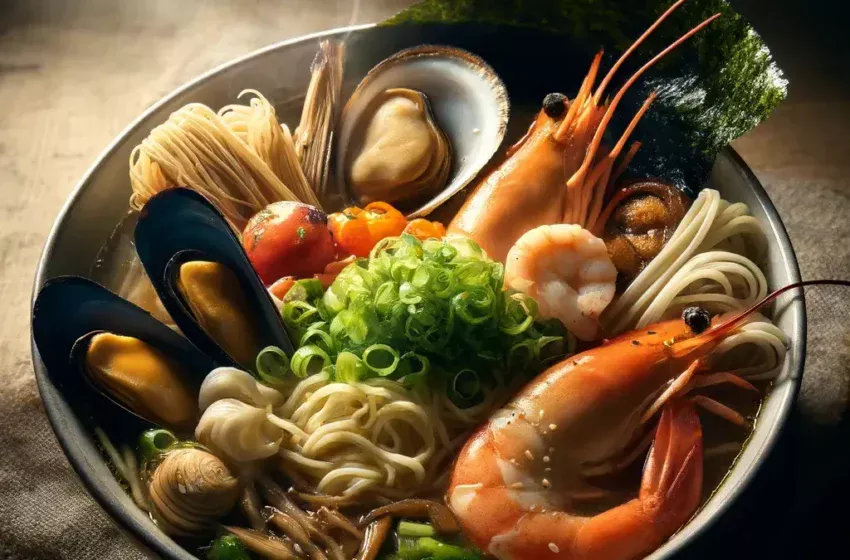Delicious Seafood Ramen Recipe – A Simple Guide to Heavenly Flavors
As a food reviewer who has had the pleasure of tasting numerous dishes from around the globe, I must say, seafood ramen holds a special place in my culinary heart. Seafood ramen is a delightful fusion of rich, flavorful broth, tender noodles, and a medley of succulent seafood, all garnished with vibrant, fresh toppings. It’s a dish that promises a taste of the ocean in every bite, making it a must-try for seafood and noodle lovers alike.
Why You Will Love This Seafood Ramen Recipe
This seafood ramen recipe is a treasure trove of flavors and textures. The broth, simmered to perfection, carries the essence of the sea, while the assortment of seafood adds both depth and complexity to the dish. The noodles, absorbing the broth’s richness, make every slurp incredibly satisfying. Plus, with the addition of fresh toppings, this dish is not just a meal; it’s an experience.
How To Make Seafood Ramen Recipe: Step by Step Guide
- Preparation Time
20 minutes - Cooking Time
30 minutes - Serves
4 People - Difficulty
Intermediate
Ingredients
- 2 liters of chicken or vegetable broth
- 200 grams of ramen noodles
- 200 grams of mixed seafood (shrimp, squid, and mussels)
- 1 tablespoon of soy sauce
- 1 tablespoon of miso paste
- 1 teaspoon of sesame oil
- 2 cloves of garlic, minced
- 1 inch of ginger, grated
- 2 spring onions, chopped
- 1 carrot, thinly sliced
- 100 grams of bok choy or spinach
- Seaweed, for garnish
- Boiled eggs (optional), for garnish
- Fresh chili, sliced (optional), for garnish
Tools:
- Large pot
- Skillet or frying pan
- Bowls for serving
Instructions
1. Prepare the Broth
In a large pot, bring the broth to a simmer over medium heat. Add the soy sauce, miso paste, garlic, and ginger. Let it simmer gently for 10 minutes to infuse the flavors.
2. Cook the Seafood
While the broth simmers, heat the sesame oil in a skillet over medium heat. Add the mixed seafood and sauté until just cooked through. Be careful not to overcook the seafood; it should be tender and juicy.
3. Cook the Noodles
In a separate pot, cook the ramen noodles according to the package instructions. Drain and set aside.
4. Combine Ingredients
Divide the cooked noodles among the serving bowls. Top with the sautéed seafood, sliced carrot, and bok choy.
5. Final Touches
Ladle the hot broth over the noodles and seafood in each bowl. Garnish with spring onions, seaweed, boiled eggs, and fresh chili slices if using.
Pro Tips For Seafood Ramen Recipe
- For an authentic taste, use freshly made ramen noodles and high-quality seafood.
- Adjust the seasoning of the broth according to your taste preferences. Feel free to add a splash of sake or mirin for an extra layer of flavor.
- If you’re a spice lover, consider adding a teaspoon of chili oil or flakes to the broth for a fiery kick.
How to Eat Seafood Ramen
To fully enjoy seafood ramen, make sure to have a spoon and chopsticks at hand. Start by tasting the broth, then move on to the noodles, followed by the seafood and vegetables. Mixing all the elements in each bite ensures a harmonious blend of flavors and textures.
Conclusion: A Culinary Journey Worth Taking
This seafood ramen recipe is more than just a dish; it’s a culinary journey that transports you straight to the heart of Japan’s rich food culture. With its complex flavors, diverse ingredients, and comforting warmth, it’s a recipe that’s sure to win over anyone who tries it. Whether you’re a seasoned foodie or a curious beginner, this seafood ramen will leave you wanting more.
If you’ve enjoyed this recipe and the flavors it brings to your table, don’t hesitate to share it with your friends and family. It’s a gesture that spreads not just good food, but also the love and passion that goes into making it.
You Can Also Read:- Ronzoni Lasagna Recipe
FAQ on Delicious Seafood Ramen Recipe
1. What is seafood ramen?
Seafood ramen is a Japanese noodle soup dish that features a flavorful broth, ramen noodles, and a variety of seafood, garnished with vegetables and sometimes eggs.
2. Can I use instant ramen noodles for this recipe?
Yes, you can use instant ramen noodles, but for a more authentic taste, fresh or dried ramen noodles are recommended.
3. What kind of seafood can I use in seafood ramen?
You can use a mix of shrimp, squid, mussels, and clams. Feel free to adjust based on availability and preference.
4. Is seafood ramen spicy?
This depends on personal preference. You can adjust the spiciness by adding or reducing chili slices or chili oil.
5. Can I make the broth in advance?
Yes, you can prepare the broth in advance and refrigerate it. Reheat it when you’re ready to serve the ramen.
6. How do I store leftover seafood ramen?
It’s best to store the broth, noodles, and toppings separately in the refrigerator and combine them when ready to eat. Consume within 2 days.
7. Can seafood ramen be frozen?
The broth can be frozen, but it’s best to prepare the noodles and seafood fresh to maintain the best texture and flavor.
8. Is seafood ramen gluten-free?
Ramen noodles typically contain wheat. For a gluten-free version, use gluten-free noodles and ensure all other ingredients are gluten-free.
9. Can I add other vegetables to the ramen?
Yes, you can add vegetables like mushrooms, corn, or beansprouts to add more texture and flavor to your ramen.
10. What is miso paste, and can I substitute it?
Miso paste is a fermented soybean paste that adds depth and umami to dishes. If unavailable, you can use soy sauce or fish sauce for a different but still flavorful broth.
11. Can I use fish in seafood ramen?
Yes, you can add pieces of fish like salmon or cod. Ensure they are cooked properly before serving.
12. How can I make the ramen broth creamier?
For a creamier broth, add a tablespoon of butter or a splash of coconut milk.
13. What if I don’t have sesame oil?
You can substitute sesame oil with another neutral oil, but sesame oil adds a distinct flavor that complements the seafood.
14. How do I peel and prepare shrimp for ramen?
Peel the shrimp, leaving the tail intact for presentation if desired, and devein them before cooking.
15. Can I make this recipe vegetarian?
For a vegetarian version, omit the seafood and use tofu and more vegetables.
16. How do I make the broth more flavorful?
Simmer the broth with additional aromatics like leek, onion, or more garlic and ginger. You can also add a dash of sake or mirin.
17. Can I use beef or chicken instead of seafood?
Yes, though it won’t be seafood ramen anymore, you can substitute with thinly sliced beef or chicken for a different version.
18. What’s the best way to serve seafood ramen?
Serve hot with all components freshly assembled, and provide chopsticks and a spoon for enjoying the broth.
19. How do I cook the noodles properly?
Follow the package instructions closely to avoid overcooking the noodles. They should be tender but still have a bit of bite.
20. Can I use water instead of broth?
Using chicken or vegetable broth adds more flavor, but water can be used in a pinch with proper seasoning.
21. How do I adjust the recipe for one person?
Simply divide the ingredients by four to make a single serving of seafood ramen.
22. Can I add cheese to seafood ramen?
While not traditional, a sprinkle of grated Parmesan or a slice of American cheese can add a unique twist.
23. Is there a low-sodium version of this recipe?
Use low-sodium broth and soy sauce, and adjust the seasoning to taste.
24. How can I thicken the broth?
A slurry of cornstarch and water added to the broth can thicken it, but traditionally, ramen broth isn’t thickened.
25. Can I use dried seaweed instead of fresh?
Yes, dried seaweed can be rehydrated in warm water before use and is a great option.
26. How do I make the boiled eggs for garnish?
Soft boil the eggs so the yolk is still slightly runny, peel them, and halve before serving.
27. Can I make this recipe spicy?
Yes, increase the amount of chili oil, fresh chilies, or add a teaspoon of spicy miso paste for heat.
28. What if I’m allergic to shellfish?
Avoid shellfish and use other types of seafood like fish fillets or calamari that you’re not allergic to.
29. Can I add rice to seafood ramen?
Adding rice is not traditional for ramen, but you can enjoy the broth and toppings over rice as a different dish.
30. How can I make this dish more sustainable?
Use locally sourced seafood and vegetables, and consider using seafood rated as sustainable by environmental groups.












